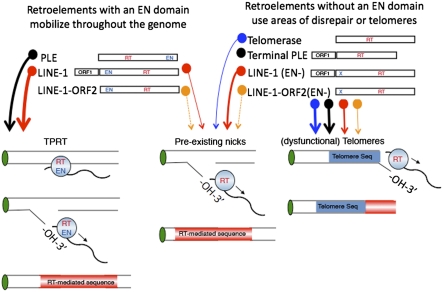Fig. 5.
Model of EN-independent retrotransposition at telomere ends: The model builds on that put forth by Curcio and Belfort (68). Retrotransposons with intact EN domains, such as LINE-1 and PLEs, can retrotranspose to internal genomic locations (conventional retrotransposition). L1s can also integrate at preexisting genomic lesions using an exposed 3′-OH for reverse transcription (unconventional retrotransposition). These retrotransposition events lack structural hallmarks, such as target-site duplications. Only retrotransposons without a canonical EN domain (L1 EN mutants and terminal PLEs) are restricted to retrotransposing to preexisting free 3′-OH groups and/or telomeric ends. Thick arrows denote a major retrotransposition pathway. Thin arrows represent a less common retrotransposition pathway. Dashed arrows represent unconfirmed retrotransposition events.

